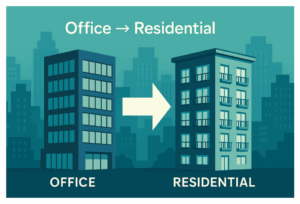The Stability of Rental Income
Real estate is renowned for its ability to generate a steady stream of income. Owning properties in high-demand areas ensures consistent rental income, which can be a reliable source of cash flow. This aspect of Wealth is particularly attractive to investors seeking a stable return in a volatile market.
Capital Appreciation: Your Path to Wealth
Over time, the value of real estate typically appreciates. This means that the properties you invest in today could be worth significantly more in the future, contributing to your overall wealth.
“Real estate is a long-term investment that often reflects the strength of an economy. Over time, well-chosen properties have the potential for substantial capital appreciation,” says Keren Divald From Renew Realty .
Tax Benefits: Maximizing Your Earnings
Real estate investments come with a variety of tax deductions. From mortgage interest to maintenance expenses, these deductions can significantly reduce your taxable income, enhancing your investment’s profitability.
Diversification: The Safety Net in Investing
Diversifying your investment portfolio is crucial, and real estate offers just that. By including property in your investment mix, you reduce overall risk, as the real estate market often moves independently of the stock market.
Leveraging Real Estate for Greater Gains
With real estate, your investment power is magnified. By using leverage – investing a small amount of your own money and borrowing the rest – you can control a much larger asset, amplifying both gains and risks.
Inflation Hedge: Protecting Your Wealth
Real estate often keeps pace with inflation. As living costs rise, so do rents and property values, safeguarding your investment against the eroding effects of inflation.
Industry Statistics: Historical data shows that real estate has maintained its value, even during periods of high inflation.
Certainly! To provide a more comprehensive and detailed blog post with calculations, I’ll extend the previous draft to include an example that illustrates the financial benefits of investing in real estate, specifically focusing on Wealth Accumulation through Land and Tenancy (WALT). This example will include a calculation to show potential rental income, capital appreciation, and the overall return on investment (ROI).
—
Financial Illustration: Understanding Wealth Accumulation through Land and Tenancy Through Numbers
Let’s break down a hypothetical real estate investment scenario to demonstrate the potential financial benefits of Wealth Accumulation through Land and Tenancy:
Example Scenario:
– Property Purchase Price: $300,000
– Down Payment (20%): $60,000
– Mortgage Amount: $240,000
– Interest Rate: 4%
– Loan Term: 30 years
– Monthly Rental Income: $2,000
– Annual Property Appreciation: 3%
Calculation:
1. Monthly Mortgage Payment:
To calculate the monthly mortgage payment, we use the standard mortgage formula.
Mortgage Payment=P×(1+r)n−1r(1+r)n
Where:
- P = principal loan amount ($240,000)
- r = monthly interest rate (4% annually / 12 months = 0.0033)
- n = total number of payments (30 years × 12 months = 360)
2. Annual Cash Flow:
Subtract annual mortgage payments, property taxes, insurance, and maintenance costs from the annual rental income.
3. Capital Appreciation:
Calculate the annual increase in property value based on the appreciation rate.
4. Return on Investment (ROI):
Add annual cash flow and capital appreciation, then divide by the initial investment (down payment).
Example Results:
1. Monthly Mortgage Payment Calculation:
$240,000×(1+0.0033)360−10.0033(1+0.0033)360=$1,146 approximately.
2. Annual Cash Flow:
Assuming $2,000 monthly rent, the total annual rental income is $24,000. After subtracting the annual mortgage payments ($1,146 × 12 = $13,752) and estimating other costs (property tax, insurance, maintenance) at $4,000, the annual cash flow is approximately $6,248.
3. Capital Appreciation:
Yearly increase in property value at a 3% appreciation rate would be $9,000 in the first year ($300,000 × 0.03).
4. ROI:
The total gain in the first year (cash flow + appreciation) is $15,248. Dividing this by the initial investment ($60,000) gives an ROI of approximately 25.4%.
—
Concluding Insights:
This example illustrates the potential profitability of a real estate investment through Wealth Accumulation through Land and Tenancy. By combining rental income and capital appreciation, investors can see significant returns on their initial investment. It’s important to note that these calculations are simplified and actual returns can vary based on market conditions, property location, and management efficiency.
Conclusion
Wealth Accumulation through Land and Tenancy in real estate is more than just an investment strategy; it’s a comprehensive approach to building and sustaining wealth. By understanding and leveraging the principles of land and tenancy, investors can achieve financial stability and growth.




